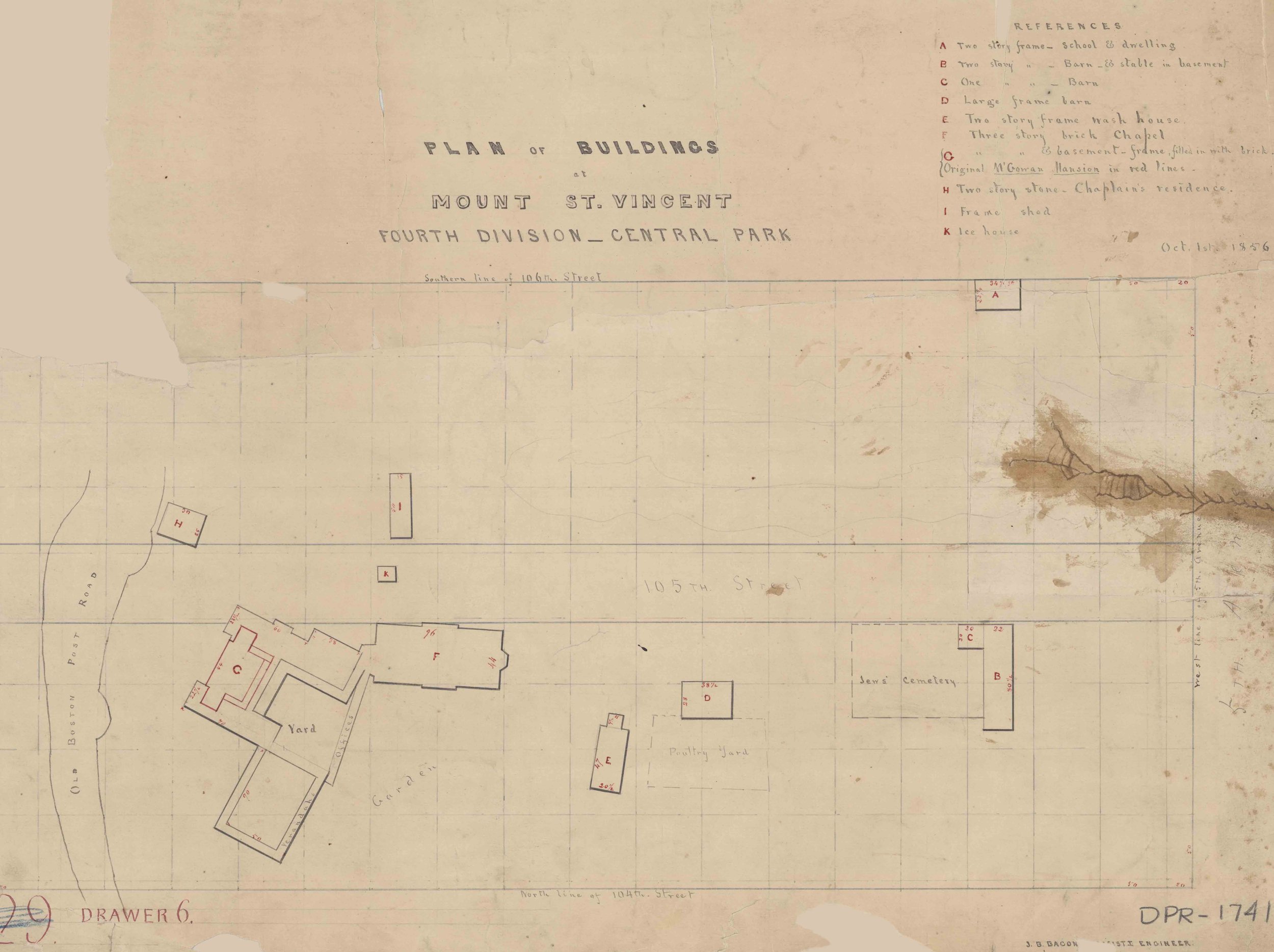New York City’s parks are open for all to enjoy year-round but the number of visitors skyrockets in the summer season. Those interested in exploring park histories are invited to research Municipal Archives’ collections for information and inspiration. Of these, the most significant is the Parks Drawings Collection which documents sixty parks, parkways, and playgrounds in Manhattan including more than 1,500 drawings of Central Park.
View at Mount St. Vincent, ca. 1863. Photo courtesy Library of Congress.
For the Record has highlighted Central Park drawings in several blogs including Skating in Central Park, The Belvedere Castle in Central Park and Central Park, a Musical Destination for all New Yorkers. This week’s article looks at the area of the park that has the richest history of use and settlement—the quiet and rustic northeastern corner. It is adapted from our book, “The Central Park: Original Designs for New York’s Greatest Treasure.”
Plan of Buildings at Mount St. Vincent, 1856. Parks Drawings Collection, NYC Municipal Archives.
Established in 1673, the old Boston Post Road—the original mail-delivery route from New York City to Boston—meandered between two rocky ridges in this area just west of what is now 105th Street and Fifth Avenue. It was here, in the mid-1750s that John Dyckman built a tavern to serve travelers on the road. Not long after, Andrew McGown purchased the land and tavern, running it successfully through the Revolutionary War giving the area its name at the time: McGown’s Pass.
McGown’s Pass Tavern, Central Park, ca. 1905. Photo Courtesy New York Public Library.
The McGown family ran a prosperous business until 1845, when they deeded the land and buildings to the Sisters of Charity of St. Vincent de Paul. The nuns renamed the area Mount St. Vincent’s and within a few years, they established a convent and school. They added a two-story residence for the chaplain to the existing structures, as well as a stately brick convent house that contained a beautiful chapel and large dining rooms. The land also included a small Jewish cemetery. In 1856, before the nuns had consecrated their new chapel, they received word that the city would be acquiring their land for the creation of the new park.
Chapel and buildings at Mount St. Vincent, ca. 1865.
The nuns relocated to The Bronx, and their buildings became the early park headquarters. At one point the families of both Frederick Law Olmsted and Calvert Vaux lived in the premises while the two men had offices in the main building. With the outbreak of the Civil War, the US government took over the complex for use as a hospital for wounded soldiers who were, curiously enough, tended by the same Sisters of Charity who had previously owned the buildings.
Mount St. Vincent Art Museum, 1863. Parks Commission Annual Report, NYC Municipal Library.
After the war, the main building returned to its original use when it was leased as a restaurant, while the chapel was transformed into a museum until it burned down in 1881. Two years later, the Mount St. Vincent Hotel, based on designs by Julius Munckwitz, was built on the site. The new building proved to be immediately popular with wealthy New Yorkers, as the New York Times reported in 1886: “No matter how fast the team nor how elegant the equipage a turn ‘on the road’ is not done in proper shape unless it includes a bite or a sip in the Mount St. Vincent.”
Mount St. Vincent, Central Park, Design for a Refreshment House, 1883. Julius Munckwitz, Architect. Parks Drawings Collection, NYC Municipal Archives.
Mount St. Vincent, Central Park, Design for a Refreshment House, 1883. Julius Munckwitz, Architect. Parks Drawings Collection, NYC Municipal Archives.
Now that it was a playground for drinking and dancing for the city’s elite, the Sisters of Charity asked that their name no longer be associated with the establishment. Renamed for the family most associated with the site, McGown’s Pass Tavern remained a popular destination through the turn of the century, but as automobiles replaces horse and carriages the business took a downturn. In 1915, Parks Commissioner Cabot Ward felt that the location would be better suited for a police station. Owner Max Boehm was ordered to vacate the premises and its contents were put up for auction. While the police station was never relocated to area, in 1917 the building was torn down. In more recent history, the location of the former convent, tavern and swanky hotel is now the home of the Central Park composting operations. Throughout the year, fallen leaves and branches are brought here and turned into nutrient-rich compost, which is used for plantings and horticultural projects throughout the Park.
Take a few minutes to view some of the exquisite drawings of Central Park in the gallery.


